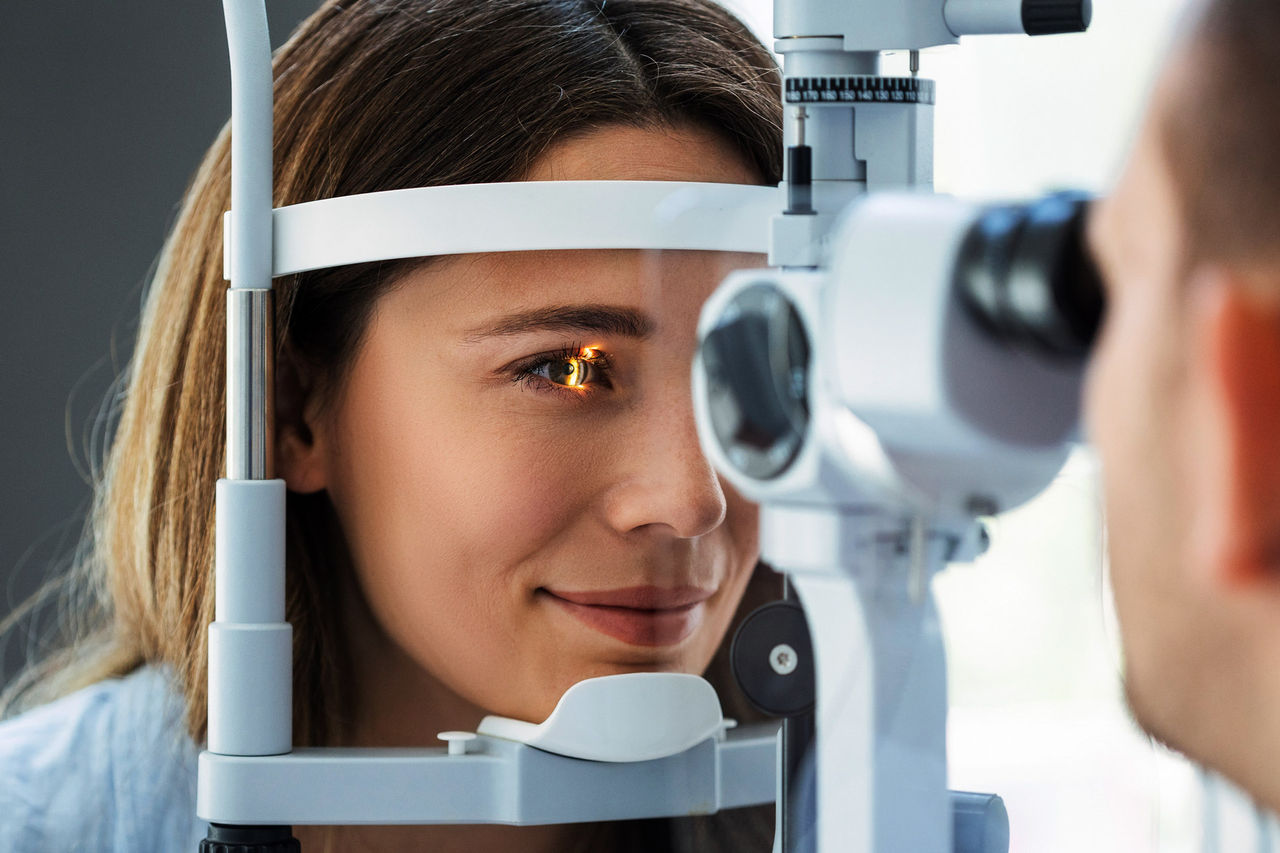Laser eye surgery: requirements, risks, methods and costs
Modern laser surgery makes it possible to permanently correct defective vision. But the procedure isn’t suitable for everyone.

Visual defects: When can I have my eyes lasered?
Be it short-sightedness, long-sightedness or astigmatism – many visual defects can now be permanently corrected by laser eye surgery. To be a suitable candidate for surgery, your eyesight must no longer change.
“We recommend a stable value over at least one year, ideally two years,” explains Dimitrios Kyroudis, ophthalmologist at the Pallas clinics in Zurich and Bern. Real life shows that many people only achieve the required stability between the ages of 21 and 25 – especially due to intensive screen consumption during their education and studies.
Which dioptres can be treated by laser surgery?
Modern laser treatments cover a wide range: Most corrections can be made safely from +5 to -8 dioptres, including up to +5 dioptres for astigmatism. If the value is higher, the procedure may be riskier – and other procedures are recommended.
Can presbyopia also be corrected with laser treatment?
Presbyopia, or age-related far-sightedness, can only be corrected to a limited extent. “Laser surgery is usually only a temporary solution in this case, as vision continues to change with age,” explains Kyroudis. Combined procedures or lens replacement are often more suitable in the long term.
“Pregnancy can change visual acuity.”
Further requirements for laser eye surgery
It isn’t only the type of visual defect that determines whether laser treatment is an option – other factors also play a role.
Age
Patients have to be at least 18 years of age. What’s more important, however, is that the visual impairment no longer changes. Stabilisation can take a little longer, especially in young adults with high screen consumption.
Healthy eyes
The eyes must be completely healthy. Diseases such as cataracts, glaucoma, corneal changes or macular problems can limit the ability to undergo treatment. “Safety always comes first,” says Kyroudis. If the patient has an eye disease, this must always be treated first.
Other factors
The thickness and structure of the cornea, tear film quality and the individual eye shape are carefully checked in advance to determine the best procedure – and minimise risks.
When is laser eye surgery not possible?
Laser treatment isn’t suitable for everyone. Reasons not to perform the procedure include a cornea that is too thin, an eye disease or worsening eyesight. It is also often not recommended for people who suffer from an autoimmune disease, rheumatism, diabetes or anyone under severe mental stress.
Laser eye surgery during pregnancy?
“Pregnancy can change visual acuity, which makes it difficult to decide whether laser treatment is appropriate,” says Kyroudis. Hormones change the tissue and can therefore also influence visual acuity. Although laser treatment isn’t dangerous, it isn’t recommended. Kyroudis therefore advises a break of at least nine months before pregnancy and also nine months after breastfeeding.
“Laser eye surgery is one of the safest medical procedures.”
What are the risks of laser eye surgery?
Modern laser treatments are considered to be very safe. However, as with any procedure, there are certain risks:
- Infections
- Clouding or scarring
- Over or undercorrections
- Dryness and foreign body sensation
- Sensitivity to light
“The more tissue that has to be removed, the higher the risk of minor complications,” says Kyroudis. However, most complications are rare. “Laser eye surgery is one of the safest medical procedures.”
After the laser procedure: what you need to bear in mind
It is important not to touch your eyes after the procedure, not to use make-up and to take a break from sport. Compared to contact lenses, however, the risk is lower in the long term: “The cumulative risks of wearing contact lenses for ten years are higher than with a single laser procedure.”
Most important laser eye surgery methods
Which laser eye surgery method is used depends on several factors, such as the thickness of the cornea, the type of visual defect and the patient’s personal situation. All procedures have one thing in common: They correct the eye’s refractive power by removing tissue from the surface or interior of the cornea. Here’s an overview of the most tried-and-tested methods.
-
LASIK: The proven classic
LASIK (laser in situ keratomileusis) is one of the most frequently performed methods of laser eye surgery in the world. A flap of corneal tissue is created in order to reshape the corneal tissue underneath with the laser. The flap is then folded back in place.
Suitable for:
- Short-sightedness (up to –8 dioptres)
- Long-sightedness (up to +4/+5 dioptres)
- Astigmatism (up to approx. 5 dioptres)
Benefits:
- Fast, pain-free, short healing time
- Rapid improvement in vision (often the next day)
Note:
- Not suitable for very thin corneas
- Be careful in the first few days with rubbing, make-up, exercise
-
FemtoLASIK: Even more precise thanks to laser technology
FemtoLASIK is the modern evolution of LASIK surgery. Instead of cutting the cornea with a scalpel, the surgeon makes an incision with millimetre precision using a high-precision femtosecond laser.
Suitable for:
- All LASIK candidates with high precision requirements
Benefits:
- Even gentler and more precise than conventional LASIK surgery
- Low intraoperative complications
-
PRK/LASEK: The method for thin corneas
Photorefractive keratectomy (PRK) and its variant LASEK work on the corneal surface, without a flap. The top cell layer (epithelium) is removed or moved aside, then laser correction is performed. These methods are particularly suitable when a flap is not recommended – for example for people with thin corneas or those who do contact sports or have strenuous jobs.
Suitable for:
- Low to medium ametropia
- People with thin corneas or an active lifestyle
Benefits:
- No flap complications
- Stable and proven over the long term
Note:
- Longer healing time (several days to weeks)
- Stronger foreign body sensation at first
-
KLEx: ReLEx SMILE / CLEAR / Smartsight / SILK: Minimally invasive without flap
KLEx stands for kerato-lenticule extraction – a particularly gentle procedure that doesn’t require a flap. It involves using a femtosecond laser to create a small lens-shaped piece of tissue (lenticule) inside the cornea, which is then removed through a tiny incision.
Suitable for:
- Moderate to severe short-sightedness
- Sensitive eyes or dry tear film
Benefits:
- Very gentle on the cornea
- Lower risk of dry eyes
- Rapid recovery, hardly any visible change
Note:
- Not yet suitable for all visual defects (e.g. farsightedness)
- Subsequent corrections slightly more complex
-
Trans-PRK / SmartSurfACE: Touch-free surface treatment
Trans-PRK (also known as SmartSurfACE or no-touch laser) is a completely touch-free method. The epithelium and underlying cornea are removed in one step without the need for an incision or an instrument.
Suitable for:
- Sporty and active people
- People with a fear of surgery
- Alternative for very sensitive eyes
Benefits:
- No contact with the eye
- Minimally invasive, can also be used for high-risk patients
Note:
- Similar to PRK: healing phase may take a little longer
- Temporary light sensitivity possible
Which method is most suitable depends on many individual factors. The decision is made by the treating ophthalmologist after a thorough preliminary examination.
How does laser treatment of the eye work?
The treatment itself is short and usually performed as an outpatient procedure. Detailed examinations are carried out in advance: Visual acuity, cornea, tear film and pupil size are measured. The procedure usually takes a maximum of 15 minutes for both eyes.
Is the laser treatment painful?
Kyroudis says that it’s not painful: “Patients often feel a little pressure – nothing more.” The procedure is performed under local anaesthesia with drops. Many patients report only a slight foreign body sensation afterwards.
How long will I be off work after the treatment?
Full vision is usually achieved after just a few days to three weeks. Temporary restrictions apply to exercise, make-up and screen work – your ophthalmologist will give you precise recommendations. Driving should only be resumed once your vision is completely stable.
How much does laser eye surgery cost?
In Switzerland, treatment usually costs between CHF 3,000 and CHF 5,000 for both eyes, depending on the clinic, method and aftercare. Important: If the price looks too good to be true, watch out for hidden additional costs and make sure you have good follow-up care over a period of three months and a possible guarantee of several years.
What costs does health insurance cover?
As laser eye surgery is an elective procedure, the costs are not usually covered under basic insurance. However, some supplementary insurance plans offer contributions or discounts. More information can be found at here at Sanitas.
Offers abroad
Laser treatments abroad – for example in Germany, the Czech Republic or Turkey – are often still cheaper, although the price difference has narrowed considerably in recent years. If you are considering treatment abroad, you should also take into account the time and costs of research, travel and accommodation.
Kyroudis also warns of possible gaps in aftercare: “In addition to the surgery itself, care after the procedure is also important. Changes or complications can occur, which is why medical aftercare should be available nearby.”
Today, laser eye surgery is a safe, effective and permanent way to do without glasses or contact lenses. A thorough preliminary examination, a reputable clinic and the knowledge that you will be well cared for after the procedure are crucial.




